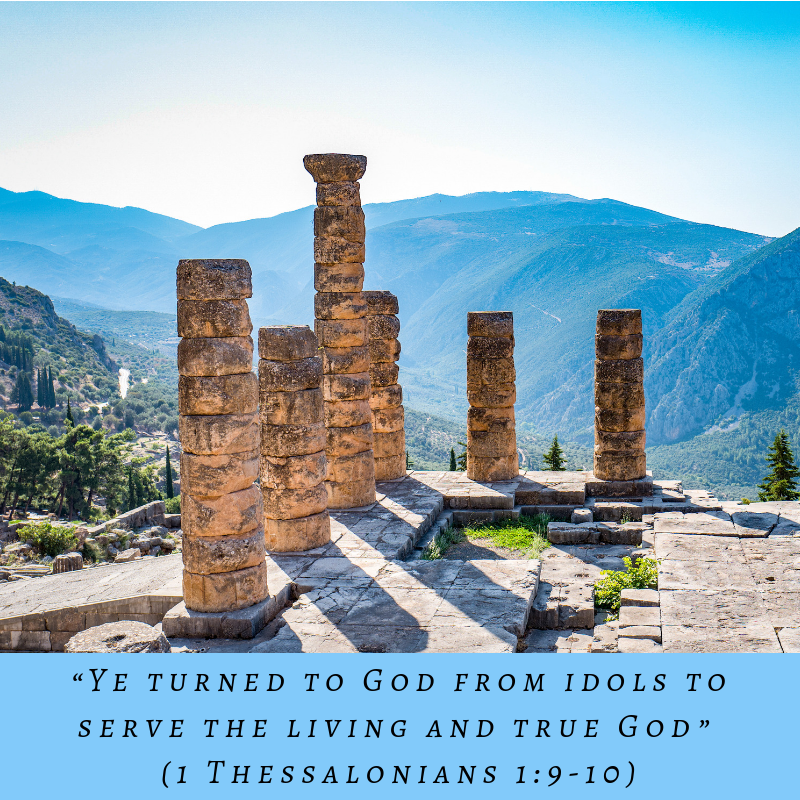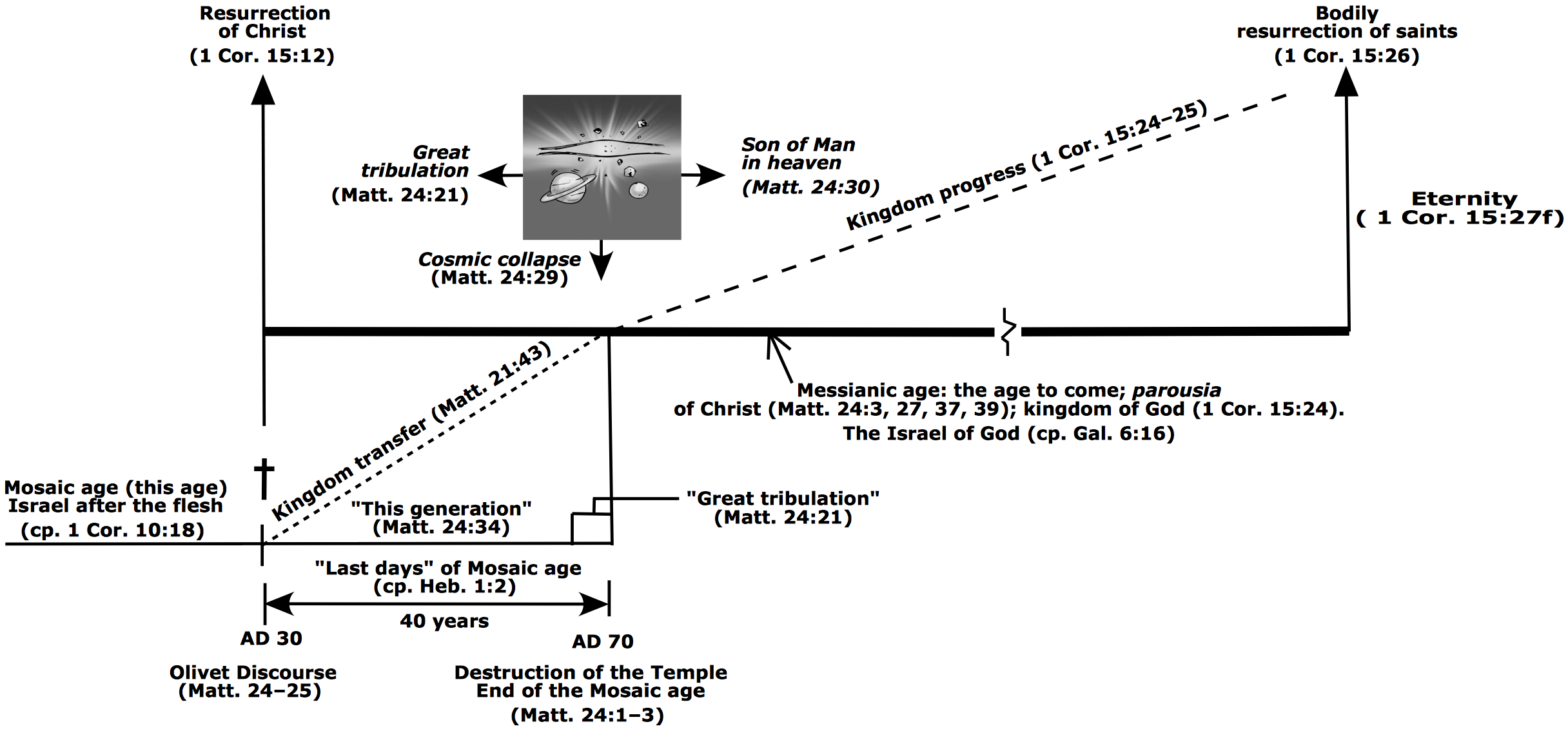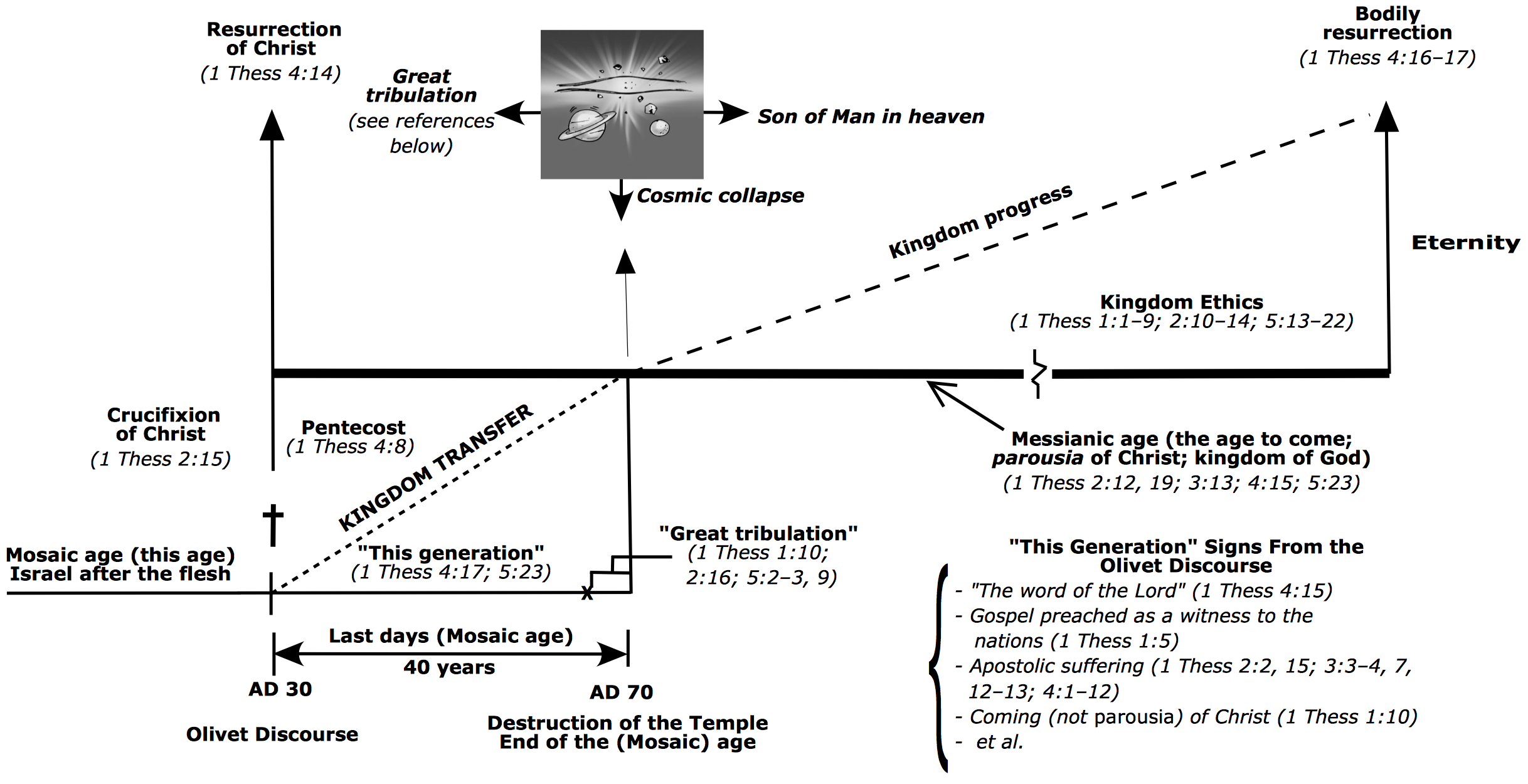
Our last post (here) gave Inmillennialism’s interpretation of the “rapture passage” (1 Thess 4:13–5:11). This post will show how it fits within Paul’s flow of thought in his letter to the Thessalonians.
Paul could “not have been in Thessalonica for more than a matter of months.”1 After persecution forced him to leave, he spent short periods in Berea and Athens (Acts 17:1–18:1). He wrote the epistle we call First Thessalonians soon after he came to Corinth early in AD 50.2
The letter suggests the Thessalonians possessed deep theological knowledge. They understood election (1 Thess 1:4). Paul could write about the Trinity—Father, Son, and Holy Ghost—without explanation (1 Thess 1:1, 5; et al.). He mentions other doctrines without stopping to explain. One wonders how Paul taught them so much in such a short time.
The composition of the church in Thessalonica provides a hint. When Paul preached Christ, some Jews there believed. They formed the nucleus of the congregation that soon included Gentiles. Paul could explain the gospel as the Jewish Scriptures fulfilled. The believing Jews could then teach others.
N. T. Wright makes an important point about how Paul viewed his message.
The full sweep of his theological understanding can best be understood, not as a random or pragmatic amalgamation of bits and pieces from his native heritage and his hellenistic culture, strung together with whatever string would hold it firm while he pressed home a particular point, but as the structurally and scripturally coherent reworking of the central themes of the Jewish heritage, monotheism, election and eschatology, articulated in such a way as to make and sustain the claim that this is the way to a full and genuine human life.3
We have already mentioned two elements of “the Jewish heritage.” Paul’s gospel of the Trinity emphasizes that Israel’s one God comprises three Persons. It also shows God’s election of Israel after the flesh (1 Cor 10:18) was a picture of his choice of a holy nation in Christ (Eph 1:4; cp. 1 Pet 2:9).
Teaching from this perspective also allowed Paul to explain the eschatology of the Old Testament prophets. Jesus fulfilled prophecies about the promised Messiah. God was about to judge apostate Israel for rejecting him. The long-awaited messianic age was a reality. Paul drew from Jesus’s Olivet Discourse to clarify the prophets’ writings.
A quick walk through Paul’s first letter to the Thessalonians will show how he developed this theme.
Inmillennialism in First Thessalonians
That the gospel had reached Thessalonica (1 Thess 1:5) was a partial fulfillment of one sign Jesus gave.4 He said, “this gospel of the kingdom shall be preached in all the world for a witness unto all nations; and then shall the end [of the Mosaic age] come” (Matt 24:14). Paul and the other apostles were fulfilling that sign.
The gospel of the kingdom had brought a division among the Jews at Thessalonica. The unbelieving ones were persecuting the Christians (1 Thess 1:6; 3:3, 7; cp. Acts 17:1–9). But, God would deliver the saints from “the wrath to come” (1 Thess 1:10). He would preserve them “unto his kingdom and glory” about to come (1 Thess 2:12). As we will see, they would not have a long wait.
Paul often reminds the Thessalonians of his suffering (1 Thess 2:2, 15; 3:3–4, 7). The apostle is not after sympathy. He wants the saints to know his suffering was fulfilling prophecy. The Jews were acting “contrary to all men: forbidding [Paul] to speak to the Gentiles that they might be saved, to fill up their sins alway: for the wrath is come upon them to the uttermost” (1 Thess 2:16; emphasis added).
Jesus had told the Jews this would happen.
Wherefore, behold, I send unto you prophets, and wise men, and scribes: and some of them ye shall kill and crucify; and some of them shall ye scourge in your synagogues, and persecute them from city to city: That upon you may come all the righteous blood shed upon the earth, from the blood of righteous Abel unto the blood of Zacharias son of Barachias, whom ye slew between the temple and the altar. Verily I say unto you, All these things shall come upon this generation. (Matt 23:34–36)
Paul was one messenger God had sent to the Jews. His suffering was helping “fill up their sins.” We now know what happened. The apostate Jews finished filling up their sins. Then “the wrath” came on them in the “great tribulation” of AD 66–70 (Matt 24:21; Rev 7:14).
Paul knew this “great tribulation” would bring the Temple’s fall, ending the Mosaic age. The faithful Thessalonians would then be his joy in the Lord’s “presence (parousia)” (1 Thess 2:19, YLT; cp. Matt 24:1–3). Until that time, Paul prayed God would continue establishing them in holiness “in the presence (parousia) of our Lord Jesus Christ with all His saints” (1 Thess 3:13, YLT).
But, by AD 50 some Thessalonian believers had died. The transition to the messianic-age parousia (presence) of Christ was not complete. The living saints wondered if their dead friends would be part of Paul’s joy in the parousia.
In the “rapture passage” (1 Thess 4:13–5:11) Paul gave a reassuring response. The saints who “are alive and remain unto the parousia (presence) of the Lord shall not have an advantage over them which are asleep.” All saints will live with Christ and take part in the resurrection on an equal footing. All will rise when Christ defeats his last enemy at the end of the messianic age (cp. 1 Cor 15:25–26).
Paul based this passage on Jesus’s Olivet Discourse, calling it the “word of the Lord.” This confirmed the messianic age parousia (presence) of Christ would come as Jesus foretold. The time for “the wrath” of God to fall was at hand. It would happen in his generation (Matt 24:34). Paul expected to live until it happened (1Thess 4:15). In his benediction, Paul prayed the Thessalonians would as well. “And the God of the peace Himself sanctify you wholly, and may your whole spirit, and soul, and body, be preserved unblameably in the presence (parousia) of our Lord Jesus Christ” (1 Thess 5:23, YLT).
Throughout his discussion of monotheism, election, and eschatology, Paul encouraged the Thessalonians to adopt a kingdom ethic. He wanted them to live as Jesus taught in his Sermon on the Mount (Matt 5–7). The transition to the kingdom age was almost complete. They should seek “first the kingdom of God, and his righteousness” (Matt 6:33; cp. 1 Thess 1:1–7; 2:10–14; 5:13–22).
Overview Chart
Past posts provided charts that apply inmillennialism to Hebrews (here) and Revelation (here). Our goal was to show how the inmillennial model accepts these Scriptures. It does not require special interpretive devices like dual fulfillment, elastic time, or prophetic perspective. We will do the same here for First Thessalonians.
Here is our generic diagram of inmillennialism:

Paul does not use every element shown here in First Thessalonians. And, he adds others not included in our generic chart. Here is our depiction of inmillennialism in this letter:

Paul uses several other signs from the Olivet Discourse in the “rapture passage.” For a complete list, see our post Paul and the Rapture — Part 2.
Conclusion
Inmillennialism finds a challenge in 1 Thess 4:13–5:11. This challenge arises not from the text itself, but from the fact most commentators place the resurrection on “the day of the Lord” (1 Thess 5:2). We have seen (here) how this causes several serious problems.
Inmillennialism’s “protensive view” (see here) offers a solution. The “day of the Lord” occurred in Jesus’s generation. The saint’s resurrection is in our future. Paul uses this perspective in other places. It is his usual way of relating the “last days” (Heb 1:2) of the Mosaic age to the end-results of the messianic age.
This view fits well within the flow of Paul’s thought in First Thessalonians, including the “rapture passage.” And, it reinforces this letter’s position as part of God’s authoritative Word to his church for all ages. It contains no errors as other prophetic models imply.
Christ rose as the firstfruits of the resurrection in the “last days” of the Mosaic age (1 Cor 15:20). This event and others—e.g., the coming of the Holy Spirit, the “great tribulation,” and the Temple’s fall—established the messianic age. Now, we wait for God to gather the full resurrection-harvest at the end of the parousia (presence) of Christ with his churches (1 Cor 15:22–26).
May God bless us to “comfort one another with these words” (1 Thess 4:18).
Footnotes
- D. A. Carson, Douglas J. Moo, and Leon Morris, An Introduction to the New Testament (Grand Rapids: Zondervan, 1992), 347.
- Carson, Moo, and Morris, An Introduction to the New Testament, 347.
- N. T. Wright, Paul and the Faithfulness of God, vol. 4 of Christian Origins and the Question of God (Minneapolis: Fortress Press, 2013), 1408. Emphasis added.
- The image in this post is Delphi Temple of Apollo by Skyring. This file (here) is licensed under the terms of the cc-by-2.0

7 comments
Thanks Mike. I find this convincing.
I appreciate your feedback!
Concerning the Thessalonians possessing deep spiritual knowledge, the passage in Acts seems to indicate there was something lacking in that the Bereans were more noble than those at Thessalonica in that they received the Word with all readiness of mind and searched the scriptures daily to see if the things Paul was teaching were so. Just sayin.
I have always understood 1Thes1:10 to being referring to the eternal wrath of God, because it is past tense. “Which hath delivered us from the (eternal) wrath to come. I would think that if he were referring to a pending temporal judgement/wrath that he would have said, “which will deliver us from the wrath to come.”
Blessings
I should have asked – did I miss reading if you mentioned 1 Thess 1:10 which seems very relevant?
I mentioned 1 Thess 1:10 in my last post (here). “Wrath upon the Jews” is the 14th item in my chart that links the “rapture passage” to the Olivet Discourse. This wrath was imminent. Paul could say, “the wrath is come upon them to the uttermost” (1 Thess 2:16). It is the judgment of God of which John the Baptist spoke. He warned the Jews about “the wrath about to break at any moment” (Matt 3:7, Wuest’s translation).
I would say, in the context of your line of thought, “The long-awaited messianic age was a reality” could be better stated, “The long-awaited messianic age was becoming a reality.”
I thought there could be an improvement in communicating your thought in the following statements: “The faithful Thessalonians would then be his joy in the Lord’s “presence (parousia).” Until that time, Paul prayed God would continue establishing them in holiness “in the presence (parousia) of our Lord Jesus Christ with all his saints.” That could appear contradictory.
I enjoyed the picture heading this post – the striking ancient ruins with a beautiful landscape for a backdrop. I think it was the best one I’ve seen. I also thought it may be your best summary of Inmillennialism.
Thank you, again, for your feedback. I understand your suggestion regarding “becoming a reality.” In one sense, the kingdom was already a reality. It had broken into the “last days” of the Mosaic age. In another sense, it had not yet fully arrived. This is not always easy to convey without making the posts even longer than they are 😉 Still, you make a good point.
Perhaps the same difficulty exists with the parousia (presence) of Christ. There was an—dare I say it?— “already-not yet” aspect to it in Paul’s day. (His “not yet” was almost always “soon.”)
And, thank you for the compliments on the image and post.